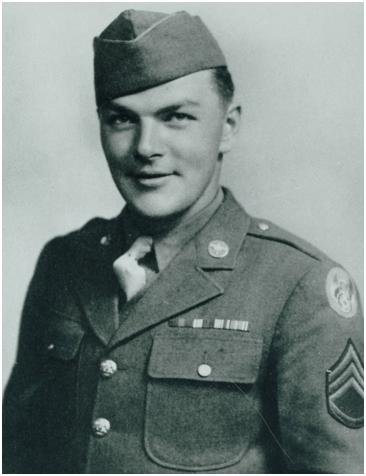Obituary of Ronald Edker Miller
Ronald was born near midnight on July 5, 1919, in Cambridge, Massachusetts to Lillian Isabella Wright Miller and Norman Edker Miller. He had one brother, Eldon Arthur, and one sister, Audrey Elvira Adkins, who both preceded him in death. He died at home in Portland, Oregon, July 11, 2011, six days after celebrating his 92nd birthday.
His parents divorced when the children were young, and they lived with their father, whom Ron loved dearly. When Eldon was in 2nd grade, he was killed in an accident in front of Ron on their way home from school. During the depression and out of work, their father took the children, and along with a military friend he had been with in the U.S. Marines, headed west to look for work. Finding no work, they finally turned around and returned as far as Indiana, where their father was no longer able to care for them, and the children were placed in an orphanage. Several months later Ron (age 9) and Audrey were taken to a train, and their father was brought to see them. The children were then sent by themselves back to Boston, Massachusetts. This was the last time Ron ever saw his father.
When Ron and Audrey arrived in Boston, their mother and stepfather were brought to see them. His stepfather agreed to take them home with them but his mother said she could not. So, the children were then made wards of the state of Massachusetts and placed on a farm. Since Audrey was too young to work, they returned her, and she was placed in a different home. Ron didn’t see her much when they were growing up and lost touch for many years.
Ron was artistic from an early age. At Buckland School (elementary) he won a gold medal with red “gem stones” from Massachusetts State for a poster contest sponsored by the Massachusetts Society and Prevention of Cruelty to Animals. In 6th grade he won an award for a watercolor of a Jack-in-the Pulpit flower. In 1932, a large bronze statue of a Mohawk Indian called “Hail to the Sunrise” was placed on the Mohawk Trail in Massachusetts, near Charlemont, the school Ron attended. Then age 13, he was selected to play a coronet solo at the dedication.
In 1937, at the age of 17 he joined the U.S. Marine Corps. At that age he had to go into field music, learning 82 calls. He played in the U.S. Marine Corps band, stationed in Washington, D.C., and performed in parades, concerts, and funerals. He later transferred to the Naval Ammunition Dump in Hingham, Massachusetts, one of the last of the Horse Marine Units—the other was in Peking, China. Eleven months after his 4 years of service ended, on December 7, 1941, Pearl Harbor was bombed, and war was declared. Ron immediately joined the U.S. Army Air Corps (later the U.S. Air Force) and spent much of the war in Fowlmere, England. He returned home on the Queen Mary. He later served 12 years in the Air National Guard in Portland, Oregon, retiring with a total of 20 years of military service. A member of the 505th Fighter Squadron of the 339th Fighter Group, Ron received an award for the many articles he wrote for their retiree’s newsletter.
Ron later learned that when he was in the service and stationed in St. Louis, Missouri, his father was also living there not far from where he was stationed. He so wished he had known so he could have seen him again. They finally connected by letter until his father’s arthritis was so bad he could not write. Once again they lost track of each other. After he married Betty, they tried to locate him and found that his father had died the year before.
Ron was a man of diverse talents and interests. He played many instruments (trumpet, bugle, coronet, drums, guitar, harmonica, Jews harp, and bagpipe), constructed a balalaika, and wrote a music book for the Air National Guard. He joined the Clan Macleay Bagpipe Band when it first started, playing in parades in communities throughout Oregon and at the Rose Bowl Parade in Pasadena,California.
His formal training in the arts included attending an art school in Massachusetts, attending and graduating from Lewis and Clark in Portland, Oregon, with a B.S. in Arts, and a correspondence course in oil painting. He did oils, watercolors, drawings, sculptures, carvings, just about anything art-related. He carved a large figurehead for a ship representing Washington and Oregon that sailed to the Tall Ship Parade in New York for the Bi-Centennial. He made model airplanes and trains and carved small figures to go with them. He constructed a model of a 600-foot transmission tower that is on Greeley Heights above the family home in Portland.
In addition to his formal training, Ron was also very much a self-taught Renaissance man. He studied astronomy, sailing, and many other subjects—he always loved learning new things, and by example inspired his children to follow their creative interests.
On March 27, 1947, Ron became a Master Mason of the Old Colony Lodge of the Grand Lodge of Massachusetts. He was proud to receive his 50 year Veteran Medal on 1997.
He was employed at Bonneville Power Administration, Multnomah County Planning Commission as an Urban Planner, and the Bureau of Indian Affairs as a Land Use Planner. He retired at age 55, and enjoyed a 37 year retirement. During his retirement he made many trips to Hawaii and across the country.
His first marriage was to Dorothy Lowe in January 1942 and they had 2 children, Ronald Bruce Miller (Cathy), and Cheryl Jeanne Munoz (Luis), 4 grandchildren, and 3 great-grandchildren. After he and Dorothy were divorced, he met Betty Lou Tiger in May, 1949. Love at first sight, they married each other on October 1, 1949, and remained married for 61 years, 9 months, and 11 days. They had 5 children, John Patrick Miller (Jeanette), Rebecca Ann Conant (Roy), Jeffrey Alan Miller, Janet Lynn Winn (Rick), and Sally Jane Stember (Matthew), 12 grandchildren, and 7 great-grandchildren.
When he was a boy there were three things that he wanted to accomplish:
When he was older he added to that list: a loving family. (Very much accomplished!)
On Sunday, July 10th, Ron was brought home from the hospital in an ambulance and placed on a hospital bed in the living room where he could watch the hummingbirds. He called for Betty several times during the day, and that night when the moon came up full and bright, he pointed at it. He died the next night, July 11th at 11:55 p.m. He had been born near midnight and he died near midnight. After his last breath, it began to rain, as if even the sky were crying.
Ronald Edker Miller lived an eventful life to the fullest up to the end. His often spoken motto was, “Any day you breathe is a good day to live.” He so loved life he never wanted it to end. And, we all loved him so much we didn’t want to ever lose him.
A memorial will be held in late October to share his life stories. We will notify those interested of the date, time and location.









